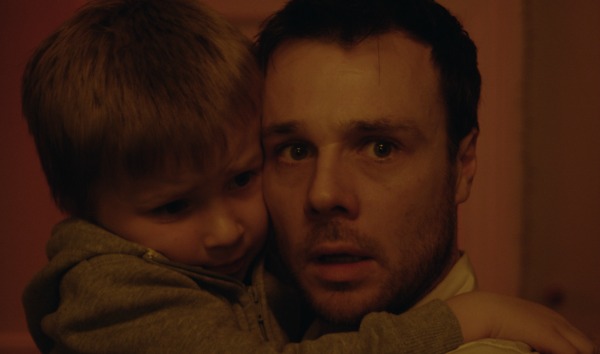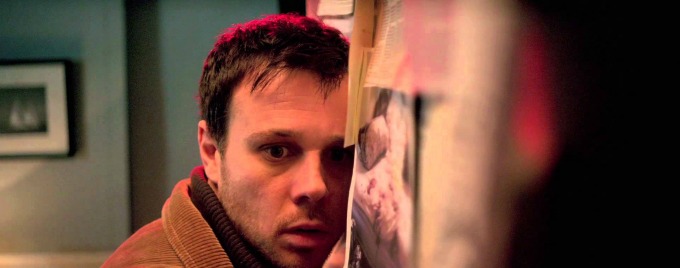THE CANAL follows David (Rupert Evans) and his family as they move into their new suburban house. All seems care free and perfect. However, it wouldn’t be a horror film if problems weren’t afoot. At his work as a film archivist, David spots that his home was the site for a number of grisly murders. As his marriage disintegrates, the footage plays on his mind, and reality and imagination become blurred. Director Ivan Kavanagh gives Edd Elliott his thought process behind the horror that unfolds.
Edd Elliott: Ivan, this is your fifth feature and second horror film. What keeps bringing you back to the genre, and what was new for you this time round?
Ivan Kavanagh: I just love the freedom of it… You can really push the medium to its limits in horror films. You can push the sound, the picture and editing almost to breaking point. It’s also the most dreamlike of the genres, I think – or at least it has the potential to be. I find it very liberating as a filmmaker.
What was different about it this time was that I was working with an editor and a sound designer for the very first time. I had edited and worked on the sound design on all my previous films… I was very lucky to find great collaborators in editor Robin Hill and sound designer Aza Hand, who were willing to experiment as much as I wanted to, and helped create what I hope is a very visceral film experience. The same would go for the deputy producer, Piers McGrail, who I worked very closely with before the film began, carefully planning the look of the film together.
EE: In Rupert Evans you have a really talented and engaging lead. What struck me the most was physically how much he changed with his character’s emotion. What was the process of creating and casting David, Rupert’s character?
IK: I usually spend a lot of time casting my films and it took me a very long time to cast the lead. But the moment I met Rupert I knew at once it had to be him. The character … needed to be handsome and likeable, but he also needed to possess a sense of vulnerability too – which Rupert has. He was also willing to push things as far as I wanted to go with the character and to go to some very dark places psychologically with him, which was good… Rupert was absolutely fearless and I couldn’t have asked more from an actor.
What I did, and I do this for all the actors, is to give them very detailed character histories, which they can then add to and enhance with their own memories from their own lives and thus create the character before we even begin filming. Then, just before the shoot, I have the actors interviewed, on-camera, in character, where they are asked a series of very personal questions and they have to answer as the character would. This not only helps them to fully understand their characters, but also reassures me that we are ready to begin filming with a fully formed character ready to go.
EE: On the subject of characters and actors, Steve Oram is brilliant in his brief moments as the dry detective, McNamara. How did his character come about?
IK: I wanted there to be some sort of comic relief, as I think the audience needs to take a breather, especially as the tension and fear level rises, so that seeing Steve’s character comes as almost a relief sometimes, as they know that at least these moments in the film will be grounded in some sort of reality and will have a different tone.
I also love world-weary characters in films … you see a lot of them in Film Noir, and I wanted the detective in this film to be a throwback to that. Also, as someone who has suffered from stomach problems most of my life, I relished writing those lines about the detective taking indigestion tablets and complaining about his “acid reflux”… There’s a lot of me in him.
Steve put a lot of work and thought into creating his character. As well as the detailed character history I had written for him, he also added great little touches that I thought made the character come alive, like deciding that the detective was probably a slob, putting dried egg on his tie as if he had spilled it while eating breakfast that morning and never bothered cleaning it up, and pushing his belly out to make him seem heavier, and filling his car with discarded fast-food papers and boxes and wearing clothes that were slightly to small for him.
EE: Sound is a large element of the film – the low base notes, the high shrieks, and even the odd bombastic horn. Talk a little about the recording of these, and what you hoped it would add to the film.
IK: I love sound. It’s my favourite part of the film-making process and I usually spend months working on the sound design. This film was no exception. We spent as long on the sound design as we did on the picture editing… What I wanted was a very raw and aggressive soundtrack, that would be of equal importance to the picture. Aza Hand, the sound designer, and the composer Ceiri Torjussen, worked tirelessly to achieve the sound that I had in my head and we created a highly complex and multi-layered soundtrack, with a lot of thought gone into each and every sound. For the music I didn’t want a traditional film score, but asked Ceiri to make the musical instruments largely unrecognisable and to create a soundtrack that would sometimes blend with the sound design so that you couldn’t tell them apart. What attracted me to working with Ceiri was that his background was not only in film scoring, but also modern classical music too, so I knew he could create that avant-garde score that I wanted.
EE: Along with the sound-scape there is some really slick editing and camera work with lots of quick jump cuts between scenes. It’s odd, therefore, that the film also appears to have a lot of reverence for traditional filming methods – film reels, wind-up cameras, fixed shots. How did you go about balancing the two in how you conceived of the film?
IK: The audience should be asking themselves throughout the film if David, or main protagonist, is imagining the things he is seeing, or if what he is seeing is real… The reason, or my thinking behind the use of the hard cuts or jump cut to the close-ups of the film running through the projector or the projector wheel spinning or the Steenbeck running, was to suggest to the audience that what you are watching may be a construct in his mind, like a film. He is after all a film archivist, and the way I always saw it was that he would be haunted by or have nightmares that would resemble horror films. Here is a character who knows all the plots, who has probably seen every horror film ever made, which is why I thought it was fun and interesting to start the film from that very traditional storyline that has been used in countless horror films before – the family move into a house with a horrible past. So this cinema archivist effectively steps into his own horror movie. It’s a very self aware film in that way, I think. Also these hard cuts are deeply unsettling and create a feeling of dread, keeping the audience on edge and letting them know that something awful is going to happen and it could happen at any moment.
Piers McGrail and I planned the look of the film very carefully … so that the film would begin with very composed shots, but as his mind deteriorates and the haunting worsens, the film itself would become more erratic. Handheld shots were reserved only for the very end of the film, for example. But there are hints at the very beginning that not all is well and perhaps not all is what it seems, when we have that very experimental barrage of subliminal shots at the beginning of the film, which were put there to unsettle and unnerve the audience, and hopefully let them know that they may be watching something a little bit different and even experimental in places. Also, since the film is a slow burner at the beginning, we wanted the audience to know that their patience will be rewarded and not to worry – the horror is coming.
EE: Sticking with the camera gaze, the film concerns itself a lot with voyeurism, particularly the searching out of ghosts and fear. David, the protagonist, is adversely affected by his interest. How do you think the audience will fare?
IK: One of the things cinema does best is to convey that sense of voyeurism. You only have to look at any number of Hitchcock films to find that out, or Brian De Palma at his best. Because this film is almost 100% from the main character’s point of view, the audience sees things the way he sees them. So what we are watching is his version of reality. The only problem is that what he’s seeing, or the way he sees things, may not be all that reliable. I hope by the end of the film that audience will have a sense that they have been inside his head, that they have been watching a living nightmare.
I think when audiences go to see horror films they want to be scared, because it’s a kind of cathartic experience. They can be terrified, but are reassured that it isn’t real. They can go home and forget all about it… The only difference with this film is that it has a very dark and disturbing theme at the heart of it, when we realise the truth at the end, and hopefully the ending will leave people haunted. I don’t think this film lets you off the hook as easily as most horror films do. I hope it stays with people, or at least images from it, for a long time afterwards. They’re the type of horror films I’ve always liked. For me, horror films are not meant to reassure us, they’re meant to scare, haunt and disturb us.
THE CANAL screens at The Cambridge Film Festival, 10.30pm on Friday 29th August and 10.45pm on Monday 1st Saptember.
httpvh://youtu.be/OZja9Hoq1jg



One thought on “Interview: The Canal”
Comments are closed.